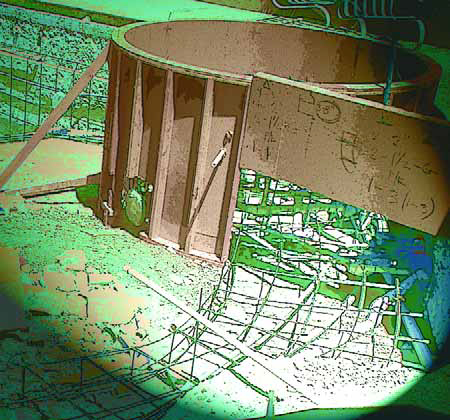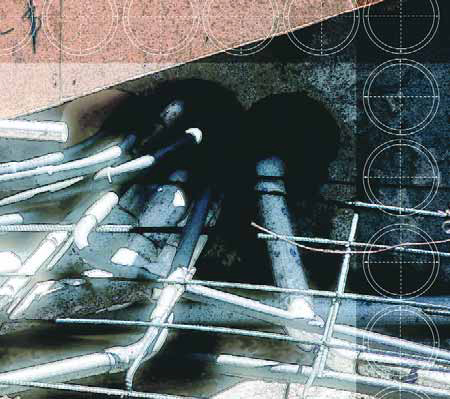engineering
As modern building materials have been developed, we humans have been remarkably proficient at applying them in ways that go well beyond the vision of their inventors. Such is the case with roofing membranes, which now are widely used as liners for backyard streams and ponds. It's understandable that landscape designers and contractors have taken to these rubber liners. After all, they make pond and stream construction inexpensive and easy. But from the perspective of the Japanese gardener or quality watershaper, convenience and affordability alone do not qualify a material for use. Instead, standards of durability and enduring
Just as with species in the animal kingdom, architectural construction styles and techniques evolve over time, adapting to changes in the environment. In the case of fountains, these evolutionary transitions have been both complex and indicative of broader trends. Ancient wellsprings, for example, eventually gave way to decorative fountains with intricately carved stone sculptures. More recently, monolithic block, walled and stepped fountain forms have held sway. It's not much of a stretch to say that the latest significant "mutation" in this remarkable lineage is the dry-deck fountain: At a time when open space is at a premium and the public is being invited as never before to interact and participate in the architectural landscape, dry-deck fountains may well be the
It's not too unusual to replace all of the plumbing, equipment and electrical lines as part of a swimming pool renovation project. It's quite another story, however, when you need to make sure all of it happens without disrupting the deck surrounding the vessel. As mentioned in my last two "Details," that's precisely what we've been asked to do in renovating a 70-year-old pool in the historic Los Feliz neighborhood of Los Angeles. The presence of a beautiful, valuable, imported limestone deck means that we've had to do all of our work from inside
Coming up in New Orleans - first during the American Society of Landscape Architects' Expo (November 1-2) and later that same week at the International Pool & Spa Expo (November 5-6) - we'll be giving show attendees a special opportunity to
The Arthur D. Kinney Natatorium was designed with a practical mission in mind: From the outset, the facility was intended to provide long-term performance, outstanding aesthetics, ease of operation and minimal maintenance life cycles while enhancing the university's recruiting efforts and fostering individual and team achievement. In this case, however, the "individuals" aren't just star athletes pursuing records and titles. Rather, the natatorium on Bucknell University's Lewisburg, Pa., campus is unique in the sense that the school chose not to segregate varsity athletes from general student/recreational users. Indeed, the facility, part of the university's grand Kenneth G. Langone Athletics & Recreation Center, is designed to bring everyone
It seems so simple: No matter whether it's a residential or commercial project, the design parameters for indoor swimming pools generally call for warm water (typically 82 degrees, or a bit less for a competition pool), air temperature two to four degrees warmer than the water, and a relative humidity in the enclosed space of between 55% and 60%. And it wasn't some committee of pool builders who came up with those figures: The numbers are endorsed and published by the American Society of Heating, Refrigeration & Air-Conditioning Engineers (ASHRAE) and have been accepted as
Graced by an abundance of beautiful, natural streams, cascades, rivers and lakes spread across spectacular native landscapes, Utah is a dream location for watershapers. Not only is there a rising demand for crafted streams, ponds and cascades that look like they really belong, but the state itself is also a genuine design laboratory. Indeed, I send our crews out into the "wild" periodically to do nothing more than hike up and down local watercourses to see how Mother Nature does things. These waterways are
If the art of watershaping is ultimately about visuals, then creating a situation for yourself in which you're virtually guaranteed to create visual disruptions is something you certainly do not want to do. That's the situation I currently face in the renovation of a pool at a stunning, 1920s-vintage home in the heart of Los Angeles. As I indicated in my last column, it's a remarkably beautiful setting that features a 70-year-old pool that was well designed, expertly installed, well worth keeping - and surrounded by
For more than two full years, this project was my personal and professional obsession. It all started in 1993, when my client, a wealthy recording-industry magnate, called on me to design the landscape for a property he'd just acquired in Bel Air, one of the most exclusive neighborhoods in Los Angeles. The Spanish Colonial-style home had been built in the 1920s and was in a sad state of disrepair. By the time I arrived, it had been gutted to the studs, and very nearly all of the hardscape and plantings around the house had been torn out as well. What he was offering me was a tantalizingly blank canvas in a most spectacular setting. In the two years that followed, not only would we
From pools, spas and fountains to streams, ponds and waterparks, effective watershaping is largely about the plumbing that makes these systems work. If you see things that way, says hydraulics expert Steve Gutai, there's nothing more fundamental to success than making proper connections in the system's plumbing lines, first time, every time, and piping joints that will bear up under pressure for the long haul.






















